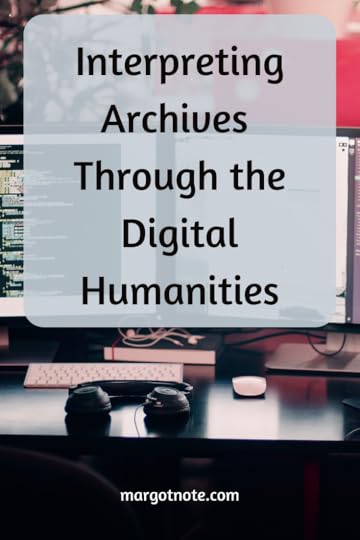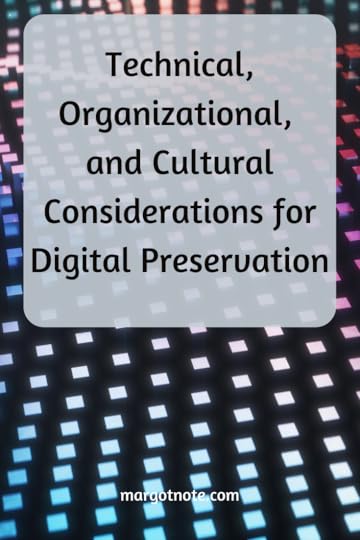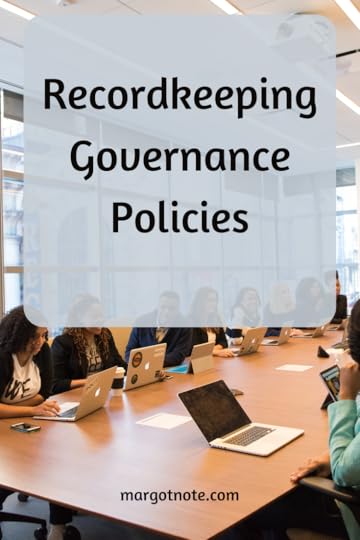Margot Note's Blog, page 18
July 4, 2022
Archival Communication, Outreach, and Training
Communications and outreach are an essential part of any archival program. Like politicians, archivists need to develop talking points to stay “on message.”
The ways to spread the word are varied, and archivists can be creative and have fun communicating their holdings’ value.
OutreachAs I define it, outreach is a personal attempt to reach out to various constituencies or would-be constituencies. Attending meetings, both within the organization and with external groups, is an effective way to get to know people and get the word out. Teambuilding with other information professionals and stakeholders is a part of the program. These are simple ideas, but the problem is that they are time-consuming; outreach in a large organization can consume all of an archivist’s time. Examples of outreach include creating a website or a webpage, scheduled emails, quarterly newsletters, committee work, and one-on-one meetings to build cooperation. Outreach methods will depend on organizational culture. The bottom line is that current and potential archival users need to know that the archival program exists and can be relied on to come to their assistance whenever needed. If outreach is done right, others will soon be passing on the archival message, and the archives program will have built support and multiplied its spokespersons.
Archival TrainingTraining is closely related to communications and outreach. Training may occur in a variety of methods. The first is general awareness training. All users can benefit from archival management awareness training of some type. Training is brief with top-level concepts. Specialized training for users with specific responsibilities or needs is a more narrowly focused training. Archivists can build on the general training and focus on the needs of specific groups.
Understanding the CultureArchivists must understand the existing environment and then determine how to change one or more aspects to improve the archival program. For example, if the organization and culture of the organization do not support archival management, the archivist may choose to strengthen the program’s basis in policy and governance. Alternatively, the archivist may turn to the education of the employees or to improving the IT infrastructure so that the role of the employees in documenting their activities and preserving records of enduring value is minimized.
Archivists need to be satisfied with good enough archival management. Organizations do not exist to create and manage records; they exist to perform some function: making money for shareholders, providing services, or protecting national security, for example. Given that fact, what is good enough archival management? The concept of “good enough” means that the basic requirements are covered. Records of enduring value should have sufficient authenticity, integrity, reliability, usability; are identified, organized, and retrievable; and are shareable, interoperable, and protected.
Implementing and supporting an archival program requires that the organizational processes be thoroughly understood and that the culture supports archival management. As much as archivists need to communicate archival values to reach new audiences, they also need to understand the perspectives of records creators.
Communicating ValueCommunicating archival value depends on the organization and its culture. How an organization views its records (and the archives program) is critical to success. People are crucial as well. If they are well trained in creating and managing records, the archivist’s job is simplified. If they resist supporting the archives, the program will have difficulty succeeding. The third concept of effective archival communication is infrastructure. Any attempt to manage records will be aided or hindered by the established infrastructure. If there is no effortless way to declare something a record, separate necessary from unnecessary ones, preserve records long term, or search across records, managing records effectively will be difficult if not impossible. Even if the culture supports archival management and the people are willing, the tools need to be in place. Organizational support, invested people, and solid infrastructure allows archivists to continue their mission of preserving records of enduring value.
The blog was originally published on Lucidea's blog.
Get StartedLooking for archival advising, records management, and historical research services? Click below to speak with an expert consultant.
Contact
June 27, 2022
Interpreting Archives Through the Digital Humanities
Many disciplines and fields in the humanities rely on the intensive use of primary sources and collecting, preserving, and facilitating access to those sources.
With the advent of technology, researchers have realigned the methods required in the digital environment for managing primary sources and research and pedagogy based on them.
Archivists’ protective treatment of primary sources in physical form as special collections is inappropriate for copies that are available in digital form; in the digital environment, archival materials can be re-edited and remixed within a network of digital storage, access, and dissemination and be viewed as data. Data include texts such as papyri, medieval manuscripts, early printed books, and contemporary literature in the humanities. They may also include artwork, architectural plans and monuments, music, field notes, photographs, videos, newspapers, television and radio broadcasts, film and film scripts, costumes and textiles, and websites.
Defining Digital HumanitiesDigital humanities using archival materials combines traditional humanities research with computational methods. Engaging the digital humanities community to work with archival collections allows users to answer old questions with new techniques and pose novel questions. Most importantly, archivists can reach new audiences. Connecting the digital humanities communities can also reunify scattered cultural records, making the illegible legible and tacit knowledge explicit. By being brave and vulnerable enough to open the archives to the digital humanities, archivists can shake up pedagogy while allowing users to understand the world taking shape around them and help to shape it as well.
By accessing primary sources—physical and digital texts, images, and audio-visual materials—digital humanity users are critical of tools, technologies, and platforms. An openness evolves from digital humanities work, stemming from open access, open-source, and open annotation methods. Users tend to be more experimental; risk-taking, redefinition, and embracing failure are benchmarks of their approach. Their practices are also collaborative. Projects often are interdisciplinary, with multiple authors and distributed expertise. Distributed knowledge production favors team contributions, crowdsourcing, and user-based interpretation. Technology-enabled projects also generate possibilities for rewarding collaborations between archivists, researchers, and technologists and among scholars whose disciplines, distance, and language have previously separated them from others.
Digital humanities projects using primary sources are iterative, agile, and process-focused, with short periods of focused work and expanded versions. Digital humanities projects using archival materials are transparent. Researchers present what is known and learn as they go. They garner feedback through public peer review and view all phases of work as valuable, not just final drafts. One way in which digital humanities offer connections is through its nature as public scholarship. Users see relevance and value in audiences beyond academia—and the archives. Their work steps outside traditional publishing models, such as academic journals, and lives online, allowing easier access to all.
Communicating ArchivesDigital humanities projects that use archives rely on technology to reveal and communicate their findings. This is especially true of projects that depend on scale. As data sets grow larger and larger, computational- and algorithmic-enabled inquiries are required. Projects include data annotation (tagging), text analysis and data mining, digital exhibitions, linked data, photogrammetry, virtual worlds, and 3-D modeling.
One example of interpretation is through locative investigation, which connects real, virtual, and interpretive sites through digital cultural mapping and Geographic Information Systems (GIS). Another is through humanities gaming with virtual learning environments that create interactive narratives and explore humanist themes. Data visualization and data design occur through virtual and spatial representations, geo-referencing and mapping, and simulated environments.
Some digital humanities findings are available through augmented editions such as marked-up and encoded texts, often created through crowdsourced methods and open to revision, sampling, annotation, transcription, repurposing, and remixing.
New Capacities for Archival ResearchNew technological capabilities promise that new knowledge based on archival materials can be produced in ways previously impossible. Projects, particularly those using text analysis in archival holdings, have advanced collective knowledge, and users understand the creation of new communication genres. Building on the large-scale digitization efforts and digital humanities tools, scholars have advanced their research, and archivists have new possibilities to assist and support innovative information efforts and communicate the value of their holdings.
The blog was originally published on Lucidea's blog.
Get StartedLooking for archival advising, records management, and historical research services? Click below to speak with an expert consultant.
Contact
June 20, 2022
Communicating Archival Value
Archives are committed to enriching human experience through their unique primary sources and heritage collections. A greater awareness of remarkable archival collections is required.
In addition, there is a need for increased public engagement, outreach, and experimental programming with archives. Archivists should consider the need to balance archival activities and collection-based curation with a commitment to reference services, outreach, and programming. Archives are not just for the past; they document human, artistic, and intellectual endeavors and make these accessible via interpersonal and digital channels.
The Purpose of ArchivesCommunicating the value of archives is advocacy. As archivists, we certainly understand the significance and importance of our work. However, the archival profession and its professional organizations have done a poor job at articulating to non-archivists the purpose of archives. Of all user and stakeholder groups, decision-makers and resource allocators are the most important to educate as they make choices that impact archival significance and labor.
Communicating archival value also involves archivists cultivating researcher groups, encouraging them to play the advocate role when appropriate, and providing them with needed information on budgetary and program development needs.
Using Reference as a Communication ToolOne powerful advocacy method is supporting more substantial reference services. Too often, reference services in archives have been narrowly defined and isolated from the rest of the archival program. Many archives lack a position, let alone a team, to coordinate the efforts relating to the promotion and use of records.
A reference role could be strengthened to serve the larger community as a public service. A range of responsibilities at the repository would include assisting in-person users, answering reference inquiries online, reaching out to research groups that could benefit from using an institutions’ holdings, advocating research use, and reporting new accessions to sources that potential users are likely to see, such as listservs, journals, forums, and select research organizations.
External reference and service promotion are equally important. For example, reference archivists could write articles for non-archival professional journals, newsletters, blogs on the nature, content, and research potential of holdings (particularly underutilized holdings). They could also propose and present sessions at professional meetings on archival resources and the research potential of holdings, and create content via presentations, workshops, and publications on how to research archival records.
Another issue is tracking the research that emerges from archives. Someone in this role could also track the use of records, measure the impact and significance of the research, and report internally and externally on the significance and implications of the research. This information could then be used for planning and management decisions that would affect the archives, such as hiring new staff, digitization efforts, and processing priorities. Compiling metrics related to archival holdings puts quantitative muscle behind the findings. When archivists can make the connection between repository holdings and research beyond the stacks explicit, decision-makers are more easily persuaded to support the archival program. By demonstrating the far-reaching influence of primary sources, archivists can communicate archival value in a language that non-archivists can understand.
Finding SupportOne recurring issue is the lack of support for reference and advocacy efforts. This especially hits smaller repositories and lone arrangers, who must try to institute these innovative ideas while still maintaining the regular workload of a typical archives. However, raising the institution’s profile through targeted reference efforts might help by providing stakeholders with concrete examples of how the archives or special collections help support the parent institution’s core mission. More stakeholders equal more support, not just in monetary terms, but by those who recognize the institution’s value. Communicating the value of records of enduring value will benefit archival programs, the profession, users, and society.
The blog was originally published on Lucidea's blog.
Get StartedLooking for archival advising, records management, and historical research services? Click below to speak with an expert consultant.
Contact
Introduction to Macro-Appraisal
Macro-appraisal, according to the Society of American Archivists’ (SAA) Glossary definition, is:
“a theory of appraisal that assesses the value of records based on the role of the record creators, placing priority on why the records were created (function), where they were created (structure), and how they were created, rather than content (informational value).”
Macro-appraisal includes functional analysis, but it goes beyond function to incorporate the three-way interaction of function, structure, and citizen. Macro-appraisal was introduced in the National Archives of Canada around 1991 to reform government records appraisal. It is described as a planned, research-based, top-down, functions-centered approach that focuses especially on the citizen’s interaction with the state.
Macro-appraisal can also be seen as a response to several problems with contemporary appraisal practice. It is hard to provide agencies with timely responses; they are doing their regular work and are not about to stop for archivists. Agencies and records creators may not prioritize their work, at least not in the ways that archivists would like them to. It also addresses the increasing problems of bulk and the importance of electronic records.
Concentration on ProcessThe focus is on the process and not the records. By process, macro-appraisal means the process in which a function is articulated, based on the interaction between structure and individual. Thus, one appraises the context in which records are created rather than the records themselves.
Macro-appraisal includes a planned, research-based, top-down, functions-centered approach. In addition, it focuses on the citizen’s interaction with the state and emphasizes processes, not records. Archivists concentrate on the functional analysis of an organization, reviewing its functions, structures, culture, and record-keeping systems. If the functional analysis reveals lacuna in what is documented, archivists try to fill in the gaps to create a more representative collection. As a combination of theory, strategy, and methodology, it is a government-wide plan for the disposition of records because it prioritizes agencies. Macro-appraisal provides criteria for assessing programs and functions within agencies by providing a methodology for appraisal within each planned submission.
Five Macro-appraisal StepsFive core steps include:
Determining the complexity and relative importance of various functions, subfunctions, programs, and activities.
Researching to pinpoint the offices or departments where the most important functions take place.
Understanding the nature and most focused site of the citizen’s interaction with the government.
Forming a macro-appraisal hypothesis of where the best records are.
Testing that hypothesis by appraising a selected group of records, looking for duplication with other areas.
By following these steps, archivists decide which functions and activities should be documented, and determine who would create those documents, the form they would take, and those with whom the creator of the records would interact. The goal is to create collections that reflect society’s values by examining the interaction of individuals with their government. Thus, at its essence, macro-appraisal theory is based on an articulation of appraisal theory (the value of the records) as distinct from archival theory (the nature of the records).
Benefits in ContextThe benefits of macro-approach include providing context and forcing a planned rather than a random approach to archival management. Macro-appraisal still allows micro-appraisal and even encourages it to confirm, reject, refine decisions; it also supports secondary values. Yet, macro-appraisal poses problems. It is resource-intensive. Issues related to changes in records creators, and shifting of functions, remain. Some argue that it is limited in its applicability to non-government settings. While not ideally suited to all environments, macro-appraisal supplies a lens to examine the documentary universe and determine what records should be preserved to represent our world accurately.
The blog was originally published on Lucidea's blog.
Get StartedLooking for archival advising, records management, and historical research services? Click below to speak with an expert consultant.
Contact
June 13, 2022
Technical, Organizational, and Cultural Considerations for Digital Preservation
The digital preservation problems archivists and records managers face are threefold: technical, organizational, and cultural.
TechnicalThe principal technical problems are technological obsolescence and media stability. Currently, typical media may be good for up to twenty years, with some optical media manufacturers claiming much longer stability; these factors also depend on external factors, such as the environment. Archivists should use high-quality, name-brand, well-tested media for long-term retention. Even with the best of care, some media (CDs, for example) are prone to failure after a period, and all media will eventually need to be replaced. The adage of “one and done” does not apply here.
Technological obsolescence is the greater issue because even stable media need hardware and software to be usable, and both hardware and software change rapidly, placing an organization on a perpetual technology treadmill to maintain usability over the years. In addition, newer technologies with higher storage densities and quicker retrieval times replace optical systems long before the optical media fail. The technologies issue also includes the explosion of data formats. A final aspect of the technology is the need to retain the documentation necessary to understand the technologies. Documentation is often maintained separately and can be lost as systems are moved offline.
OrganizationalTwo major areas of organizational problems are preservation planning and commitment to preservation. Many institutions do not plan for the long-term retention of records from systems owners and IT staff. Planning and budgeting for long-term retention is hard because the costs are down the road, often after many managers are either retired or have moved on. In addition, funding for long-term retention and preservation is usually removed from budgets because current needs take priority over future ones. Frankly, many decision-makers see the future as somebody else’s problem.
The related issue is long-term organizational commitment. Many organizations get into electronic recordkeeping for its short-term advantages, such as improved access, retrievability, reuse, and repurposing. However, most of these real benefits are on the information management side of the ledger, e.g., for facilitation of transactions or for use as evidence of transactions, rather than as evidence for longer-term legal, financial, and rights and obligations purposes. Once the active life benefits are exhausted, the idea of maintaining the records in usable form becomes an expense that is eliminated by putting the records into long-term storage without thinking of the infrastructure (e.g., hardware and software) that will be needed to access them later. In some cases, the electronic records are abandoned when a project is over, or the unit is reorganized.
CulturalThe most straightforward answer to the technological and organizational problems described above would be to manage the electronic records in the first place, breaking them into series to separate the ones that would need long-term retention from the ones that would be disposable and then making cost/benefit decisions about the formats for long-term retention. The major cultural block to this is the inability to see beyond the current needs to a time when the organization will not need all of the information in electronic form. The second cultural block is the unwillingness of individuals and organizations to face up to their responsibilities for the long-term maintenance of records. With paper-based collections, long-term care was a low or no-cost issue for management. Archivists and records managers handled it, and the problem went away from management’s perspective. Now the problem is recurring and cross-organizational, requiring at least periodic if not constant attention. Unfortunately, many organizations are unprepared for this shift in responsibilities.
The Path to PreservationIn the coming years, the information management field hopes that digital preservation will be simplified as archival materials are migrated to an ever-narrowing range of formats. Until then, archivists, records managers, and other allied professionals must contend with the technical, organizational, and cultural roadblocks that impede the path to preservation.
The blog was originally published on Lucidea's blog.
Get StartedLooking for archival advising, records management, and historical research services? Click below to speak with an expert consultant.
Contact
May 30, 2022
Artist-Driven Archives
Archivists organize collections through appraisal, accessioning, processing, and preserving the materials. The goal is to provide access to the materials.
Collections arise out of an organization’s operations which are no longer in use and will not undergo further intentional modification other than preservation once they have been accessioned.
In the case of archives created by artists, the materials may include film or video documentation, photographs, programs, newspaper clippings, oral histories, sketches, musical scores, correspondence, rehearsal notes, budgets, and other items. Archivists endeavor to preserve the provenance and original order of the materials. While archival professionals gather these records as part of the appraisal and accessioning process, they are not typically collected to create a specific story. Instead, the goal is to create a consistent structure across collections within a particular archive that enables uniform searching.
Creative ArchivesA growing trend among creators is to create artist-driven archives as part of their artistic work. Like performance projects, artist-driven archives highlight how creators have a history of turning to archives (their own or others’) for inspiration. Artist-driven archives result from an ongoing creative process. They differ from traditional archives because the materials are still in active use by the individuals who generated them, and they may shift over time rather than being preserved in their original order. Such archives collect materials related to a single artist’s work, either as a whole or focusing on one era or specific project. Of importance to this approach is that the materials are about the artist’s self-representation. Primarily, the artist-driven archives aim to articulate something about an artist’s ongoing body of work and artistic process rather than enabling the preservation of materials. Artist-driven archives delineate the unique possibilities of each creator’s body of work, even as the various components of the archives may also exist as artworks. Indeed, when artists engage with their archival materials, they can choose the form their archives take, which gives their archives a consistency with their creative practices.
Present vs. FutureIn addition to providing artists with new methods to articulate their practice, artist-driven archives are also aimed at being accessible to broad audiences in the present, rather than existing primarily for research in the future. Artist-driven archives are intended to expand the accessibility of the work to new audiences. The premium placed on accessibility means that these artist-driven archives employ digital, online, and innovative platforms; museum and gallery exhibitions and installations; and live performances, rather than a repository model. Archival users can learn something about the art when it was first created, but they may also experience the artistic process or even experiment with creating their mix of the materials, even as the artist is engaged in the same process. This approach brings users into the art-making process in ways that are not generally available to them.
Coexistence of Traditional and Creative ArchivesWhereas repositories control access to materials and dictate how they may be handled with the goal of long-term preservation, the artists creating artist-driven archives specifically seek to expand access to as many people as possible. However, artist-driven archives are not replacements for traditional repositories. Indeed, the latter will continue to play a significant role in scholarship. Instead, artist-driven archives offer further opportunities for audiences, researchers, and even the artists themselves to engage with the work in new ways. While traditional archival practices are not as experimental or fluid as artist-driven archives, archivists in all settings can learn from creators who push the boundaries of archival innovation, access, and outreach.
The blog was originally published on Lucidea's blog.
Get StartedLooking for archival advising, records management, and historical research services? Click below to speak with an expert consultant.
Contact
May 23, 2022
Creative Use of Archives
People may come to the archives as part of their creative process to expand upon or enhance a current project with archival research.
For example, authors of historical fiction, poets looking to explore visual resources, and dramaturges digging into sources to get background information for costume design can be informed by archival materials.
Archival collections inspire and inform creativity, allowing users to learn about different eras and view historical objects directly. To see how something was made or to imagine what may have inspired the creator is a very potent stimulus to the imaginative engagement with the past.
Archival UseArtistic engagement can take many forms. Artists have used archives to explore various topics, including culture, identity, memory, social systems, and politics. Creative engagement with the archives broadly fits into three main categories, which can overlap. The artist can be an archivist, an archival user, or an archival commentator.
Archival-based artwork does not always contain or display primary sources. However, in some cases, artists utilize the archival collections themselves, rather than the information they hold, to form part or all of a creative piece. The use and meta-use of archives are particularly exciting when artists use, interpret, and recreate visual and audiovisual records creatively.
Some Understandable ReservationsArchivists, who strive to preserve context, may understandably have reservations about the creative use of archives when they know this may help eliminate their intellectual control over the archives. Furthermore, the removal of context by artists may impact the future understanding of the original archives. However, archivists need to contend with many ethical, political, and professional questions about removing context from archival material—especially sensitive archival material. For example, is it acceptable to allow archival material to be potentially misrepresented? Where exactly does our professional duty to defend the moral integrity of our archives begin and end?
These questions presume an underlying assumption that there is one correct interpretation inherent in primary sources. There is also a notion that repositories and their archivists possess the right and ability to establish a correct understanding and then judge if a user has interpreted it correctly. Users, coming to their conclusions, may be seen as undermining the character and authenticity of archives, with certain usage of parts of the original whole seen as ethically wrong.
Tackling such issues practice may cause tensions between archives and their users. A deeper problem could be tension between archives and their donors due to the creative use of their archival materials. Some archives have tried to preempt such conflict by setting clear boundaries regarding the creative use of archives through the use and access policies and donor agreements.
Archival ProgrammingArts programming is another way to attract new and different users to archives. It exposes a wide range of people to arts of all kinds and promotes local arts organizations and individual artists. It also provides opportunities for users to interact with artists in their community, which allows them to learn from peers and develop their artistic skills.
The development of national arts programs that individual states, cities, and towns can tap into is one significant way the web has benefited the arts community. Examples include National Novel Writing Month (or NaNoWriMo), National Poetry Month, the Big Read/Dance/Draw, and National Craft Month. More traditional annual events are National Archives Month or History Day.
Major organizations administer these programs nationally by providing marketing toolkits, program how-tos, forums for asking questions of other organizations, logistics, and planning tips. These programs are an excellent opportunity for practicing artists to raise awareness of their craft and engagement with their community; equally, archivists can tap into a vibrant group of local artists to provide new life into collections.
No matter what form the creative approach to archives takes, the key factor is welcoming access to historical primary sources for new and non-traditional users.
The blog was originally published on Lucidea's blog.
Get StartedLooking for archival advising, records management, and historical research services? Click below to speak with an expert consultant.
Contact
May 16, 2022
Recordkeeping Governance Policies
Policies for recordkeeping need to articulate several areas, including purpose, definitions, roles and responsibilities, and the functional areas of managing records that the organization needs to implement.
Each organization’s policy is different, sometimes because the policy must conform to the organization and its mission and values.
The Policy FrameworkSeveral policy issues need to be considered when establishing a policy framework. The first is accountability. The policy needs to clearly state the roles and responsibilities of employees to create and maintain records and the authorized duties and activities of the archives and records management programs. Accountability for these programs should always start from the top and be delegated. The policy should include program managers, system owners, IT staff, and all employees.
The second is the “tiering” of policy requirements. In large organizations, the policy will be a high enough level to accommodate all parts of the organization. There will be a policy flow down from the organization to significant components to minor components in such cases. This is necessary to ensure that the guidance offered to employees is sufficiently specific to enable implementation. The result may be called organization-specific policies, or they may be called implementing procedures. That is an organizational culture and governance issue, but in any case, the flow down is essential for ensuring that the policy is implementable. There must be a continuum between the organization-wide requirement to create and maintain documentation of activities and the requirement that a personnel file contains specific documentation.
The third is policy placement. Archives and records management programs need policies that are part of the comprehensive compendium of policies in the organization. However, few people will ever bother to read these documents, no matter how well it is communicated. These policies and recordkeeping requirements should be integrated into the IT system development process in the employee manuals.
Program PlacementLastly, consider the programs’ placements. Where do archives and records management programs belong in an organization? There is no perfect placement, and much depends on the organization itself. Places include:
Organization Executive: Archivists or records managers reporting directly to the organization’s executive level would be optimal. However, this rarely happens because few programs of any kind report there directly.
IT Office or Office of the CIO: This seems logical given the emphasis on electronic records and can work well if the CIO wants to have documents as part of their organization. It means that the programs are organizationally close to systems activities, which influences IT policy, process, and infrastructure. The IT department generally has money as well, which is useful. However, if the head of IT is not interested in records and sees them as a burden, then the programs will have little influence within IT and even less outside of it because external relationships must go through the head of IT.
General Counsel: The Office of the General Counsel (OGC) often relies on archivists and records managers for evidence of organizational activities, but the OGC wants to use records and not be responsible for the program. Often, legal departments make better stakeholders and advocates for archives and records management than homes for their programs.
Support Services: Some organizations have an office of support services that provides IT and administrative services and security, facilities, and other tasks. Administration can be a home for the program and a useful one if archivists and records managers report directly to the head of the support services group rather than through someone else.
Library: In this case, the archives and records management programs are seen as another information resource. The downside is that the archives and records management programs are viewed as retrieval repositories, not creation management engines. It can provide a start but usually is not the basis for a complete program.
Making It WorkAny location can be made to work. However, what archivists and records managers need, regardless of where they reside within an organization, is executive support, the ability to influence decisions that involve records, resources (budget and staff), and the opportunity to make strong alliances with stakeholders and others throughout the organization.
The blog was originally published on Lucidea's blog.
Get StartedLooking for archival advising, records management, and historical research services? Click below to speak with an expert consultant.
Contact
May 9, 2022
Records and Business Change
All organizations produce records, but the role that records play in organizational processes is not always recognized.
Steps in the process may be poorly laid out, or the process may contain extra steps, vestiges of earlier departments, or no longer needed requirements. Often archivists and records managers are told that specific documentation (often in hard copy) was created because records management requires it, even though no such requirement exists. Archivists and records managers should be experts in the documentation needed for each business process to satisfy internal and external conditions, which is their significant contribution to supporting business change. They should understand which of the documentation steps are required, optional, or simply convenient. It is up to archivists, records managers, and other information professionals to advise in these areas. Otherwise, business owners and others will always opt for creating and maintaining everything since they cannot be sure what is necessary.
Three Major ChangesArchivists and records managers get involved in business change at three points. The first is the creation of new business processes or systems to support them, where they help identify the requirements for documentation and how creating the documentation can be integrated into the process as seamlessly as possible. The second is the reengineering of business processes, where the focus is on improving the operational efficiency and effectiveness of the process while maintaining good enough recordkeeping. The third is mergers, acquisitions, divestitures, and closures, where records must be brought together, divided, or disposed of in ways that maintain their ability to meet future recordkeeping needs.
Organizational EfficienciesArchivists and records managers assist in making the business process as effective and efficient as possible, contributing to organizational success. Seven areas where archives and records management can help organizations include:
Improving operational efficiency
Reducing costs
Improving customer service
Enhancing regulatory compliance
Driving faster time to market
Helping grow revenue
Increasing competitive advantage
These activities may be easier for paper records than electronic ones. However, most organizations have vast amounts of unstructured data, almost always poorly described, that must be managed. Applications that create and maintain business transaction records and business records are of the most interest, but records that document intellectual property are of equal importance and often not easily recoverable. In any case, there will be a large volume of digital objects that will have to be dealt with somehow. Dumping the accumulated records of the organization on information professionals only delays the difficult decisions about what to keep and what can be set for disposal. Making an intelligent decision will take a team effort, led by archivists and records managers but cross-cutting concerning organizations and expertise.
Change ManagementNo matter what organizational change is taking place, change management will play an essential role in the success of the process. Change management is a systematic methodology for supporting employees as an institution transitions to new processes, tools, or initiatives. Even a slight change in an organization can lead to fear and frustration among the staff if the change is managed poorly. However, a well-thought-out change management process can help a company make needed adjustments smoothly and successfully.
Many organizational change initiatives have failed because of the lack of attention to the management of the changes and attention to the needs of the staff who are the ones most affected. Especially when the change involves automating the creation and management of records and other information assets, staff resistance is the most frequent cause of system breakdowns.
Overseeing ChangeCompetitive businesses must adjust priorities, adopt new processes, and pivot more frequently. Because these adjustments can be disruptive to the people within an organization, any business that wants to transition successfully should make managing change a core competency. Helping to manage change—and the records that change creates—is the domain of information professionals.
The blog was originally published on Lucidea's blog.
Get StartedLooking for archival advising, records management, and historical research services? Click below to speak with an expert consultant.
Contact
May 2, 2022
Connection through Genealogy and Family History
Many archival programs have crafted opportunities to welcome community members who might not have thought about coming in before. The wider the user base of the archives, the better the awareness will be of the archival repository, especially if it has a local focus.
This is especially true of communities with changing demographics because the newer residents would not have a natural connection to the area’s past; archival programs can speak of the history of the area, actively solicit materials, and engage with their contemporary communities. The programs can also range in target age from children to adult learners, so archivists can create various ideas to experiment with.
Local History ResourcesAn essential part of archives is documenting a historical place: “place” can be a town, county, state, or region. The important part is that the materials capture aspects of the history of the area and its residents, past and present. Local history guides may provide a comprehensive account of the area, oral histories, and genealogy resources. The archives can also solicit donations of materials, as whole collections or in part, such as postcards that depict the area. Historic photographs; local court records, military records, vital statistics, and newspapers on microfilm; and high school yearbooks are also popular materials.
Genealogy ProgramsAn archival department can also focus on genealogy-based outreach programming, such as creating family trees and researching ancestry. A show-and-tell of family heirlooms can allow users to share stories about their past. Sharing photos raises awareness of the universality and change of “family” over time, and screening home movies bring snippets of life to light. Providing educational resources on digitizing these materials can prove invaluable to patrons and can be a proactive way of saving local history before it gets damaged or destroyed. DNA-based genealogy is a popular and controversial topic; bringing in an expert to speak on the subject may bring potential new users to the archives.
Partner with Local OrganizationsIf your organization does not hold local history or genealogy materials, you may wish to collaborate with a local genealogical and historical society for history-based events. Local experts can present programs to inform users about their neighborhood, town, or county, and demonstrate other archival resources you already maintain. Allow new audiences to learn about prominent personalities, their families, and achievements; conversely, a local historian can discuss the area’s hidden history to reveal untold stories. Highlight community authors who write about your locality. Invite them to discuss their research into the town to promote their work.
Preservation for the PeopleAnother way to connect people to the value of archives and primary sources is to provide information about preserving their cherished family and personal materials. Staff members can host workshops on preserving materials, demonstrating the decisions and techniques archivists use on collections that can be used in home archives. If there is a museum or university in your area, ask a conservator or preservation specialist to lead a workshop and talk about the storage and handling of family documents, letters, and photographs. When I wrote a book on creating family archives for a general audience for the Society of American Archivists, I was surprised by the number of queries I got regarding hosting webinars and programs for historical societies and libraries. They were looking for opportunities to explain their everyday duties to local audiences and connect through legacy. Creating archives is the process of preserving, organizing, and protecting something precious. It applies to physical and digital materials that capture moments and memories. Finding opportunities to show archival work reminds users that a family story is more than just facts likes names, dates, and events. Documents record private and public thoughts and personal and professional interactions, and the stories they contain may be of interest to people beyond family members, perhaps future users of the archival repository.
Strengthening ConnectionsThese are just a few of the many options available to bring more local history and genealogy-related programming into your organization. Archivists are delighted to help their users discover more about their family history, become engaged in the community, and forge connections.
The blog was originally published on Lucidea's blog.
Get StartedLooking for archival advising, records management, and historical research services? Click below to speak with an expert consultant.
Contact



